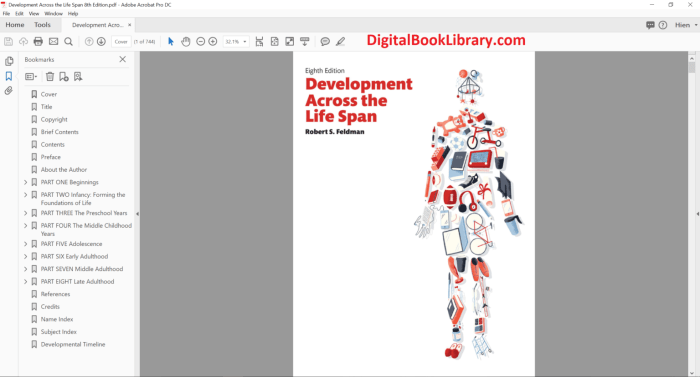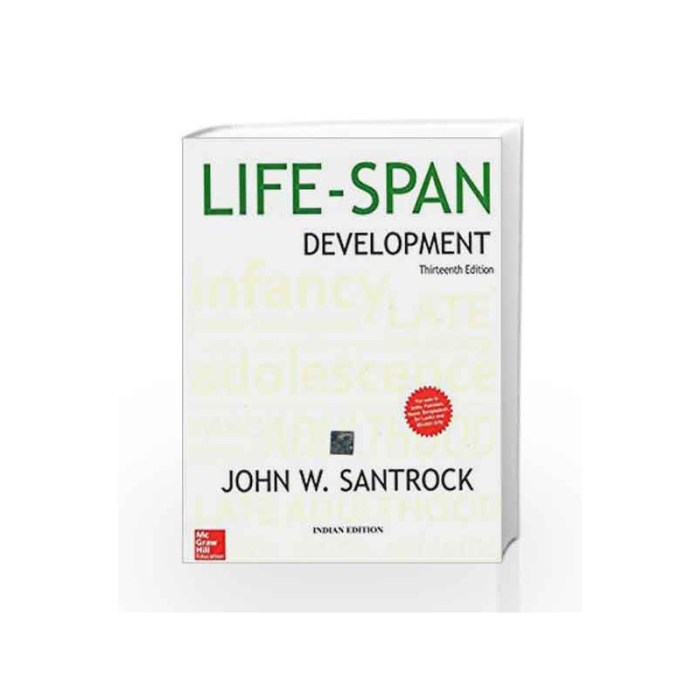Life Span Development 18th Edition embarks on a captivating journey through the intricacies of human growth and development, offering a comprehensive exploration of the physical, cognitive, social, and emotional transformations that shape our lives from conception to old age.
This authoritative guide delves into the historical foundations of the field, unravels the key theories that have shaped our understanding of human development, and provides a nuanced examination of the complex interplay between biological, environmental, and cultural factors that influence our developmental trajectory.
Introduction to Life Span Development 18th Edition

Life span development is the study of human development from conception to death. It is a multidisciplinary field that draws on insights from psychology, sociology, biology, and other disciplines. Life span development researchers are interested in understanding how people change over time, and how these changes are influenced by both biological and environmental factors.
The field of life span development has a long history, dating back to the early days of psychology. In the early 20th century, researchers such as G. Stanley Hall and Arnold Gesell began to study the physical, cognitive, and social development of children.
In the mid-20th century, researchers such as Erik Erikson and Jean Piaget began to develop theories of human development that spanned the entire life span.
Today, life span development is a thriving field of research. Researchers are investigating a wide range of topics, including the effects of early childhood experiences on later development, the role of social support in aging, and the impact of technology on human development.
Key Themes and Theories in Life Span Development
There are several key themes that run through the field of life span development. These themes include:
- Development is lifelong.Development does not stop in childhood or adolescence. It continues throughout the lifespan, from conception to death.
- Development is multidimensional.Development involves changes in physical, cognitive, social, and emotional domains.
- Development is influenced by both biological and environmental factors.Genes play a role in development, but so do experiences, culture, and other environmental factors.
- Development is plastic.The brain and other organs are capable of changing and adapting throughout the lifespan.
- Development is contextual.Development occurs in the context of family, culture, and society.
Physical and Cognitive Development

Physical Changes
The human body undergoes a number of physical changes throughout the lifespan. These changes include:
- Growth in height and weight.Children grow rapidly in height and weight during the first few years of life. This growth slows down during adolescence, but continues at a slower pace until adulthood.
- Changes in body composition.The body composition of children and adolescents changes as they grow. The proportion of body fat decreases while the proportion of muscle mass increases.
- Development of sexual characteristics.Sexual characteristics begin to develop during adolescence. These changes include the growth of breasts in girls and the growth of facial hair in boys.
- Changes in the brain.The brain undergoes a number of changes throughout the lifespan. These changes include an increase in the number of neurons and the development of new neural connections.
Cognitive Changes
The human brain undergoes a number of cognitive changes throughout the lifespan. These changes include:
- Development of language.Children begin to develop language skills at a young age. They learn to understand and produce words, and they begin to use language to communicate with others.
- Development of memory.Children’s memory skills develop rapidly during the first few years of life. They learn to remember new information, and they begin to develop strategies for remembering information.
- Development of problem-solving skills.Children’s problem-solving skills develop gradually throughout the lifespan. They learn to use different strategies to solve problems, and they become more efficient at solving problems.
- Development of critical thinking skills.Children’s critical thinking skills develop gradually throughout the lifespan. They learn to think critically about information, and they become more able to evaluate the validity of information.
Interactions Between Physical and Cognitive Development
Physical and cognitive development are closely intertwined. For example, the development of language skills is dependent on the development of the brain. Similarly, the development of problem-solving skills is dependent on the development of memory skills.
Social and Emotional Development

Social Changes, Life span development 18th edition
The human being is a social creature. We interact with others throughout our lives, and these interactions shape our development. Social changes that occur throughout the lifespan include:
- Development of attachment.Children develop attachments to their caregivers during the first few years of life. These attachments provide children with a sense of security and safety.
- Development of friendships.Children begin to develop friendships during the preschool years. Friendships provide children with opportunities to learn about themselves and others, and they help children to develop social skills.
- Development of romantic relationships.Romantic relationships begin to develop during adolescence. These relationships provide young people with opportunities to learn about intimacy and commitment.
- Development of social roles.People develop social roles throughout their lives. These roles include roles such as student, worker, parent, and spouse.
Emotional Changes
The human being is an emotional creature. We experience a wide range of emotions throughout our lives, and these emotions shape our development. Emotional changes that occur throughout the lifespan include:
- Development of self-awareness.Children develop self-awareness during the first few years of life. They begin to understand their own thoughts, feelings, and desires.
- Development of emotional regulation.Children develop emotional regulation skills throughout the lifespan. They learn to manage their emotions and to express them in a healthy way.
- Development of empathy.Children develop empathy during the preschool years. Empathy is the ability to understand and share the feelings of others.
- Development of self-esteem.Children develop self-esteem throughout the lifespan. Self-esteem is the belief that one is worthy of love and respect.
Interactions Between Social and Emotional Development
Social and emotional development are closely intertwined. For example, the development of attachment is dependent on the development of emotional regulation skills. Similarly, the development of empathy is dependent on the development of social skills.
Question & Answer Hub: Life Span Development 18th Edition
What are the key themes in life span development?
Life span development encompasses several key themes, including plasticity, multidirectionality, historical and cultural context, and the dynamic interplay between nature and nurture.
How does life span development influence education?
Understanding life span development is crucial for educators as it provides insights into the cognitive, social, and emotional needs of learners at different stages of their lives, enabling them to tailor teaching strategies and create supportive learning environments.
What are the implications of life span development for public policy?
Life span development research informs public policies related to healthcare, education, social welfare, and aging, ensuring that policies are responsive to the changing needs and challenges faced by individuals throughout their lives.
